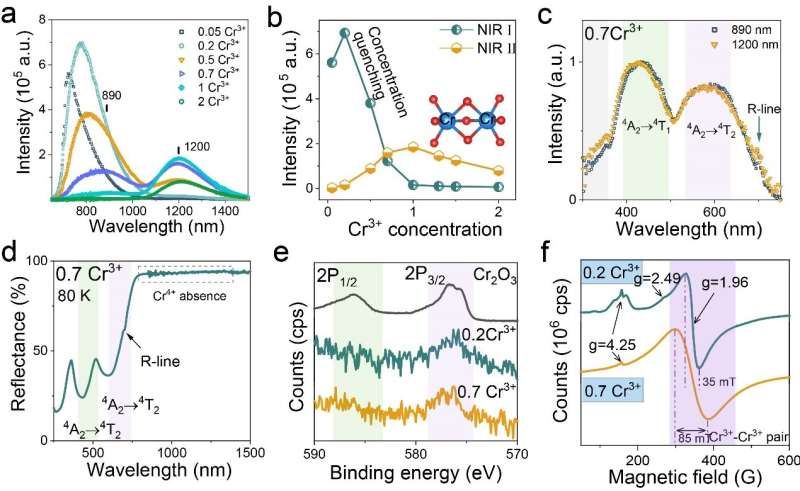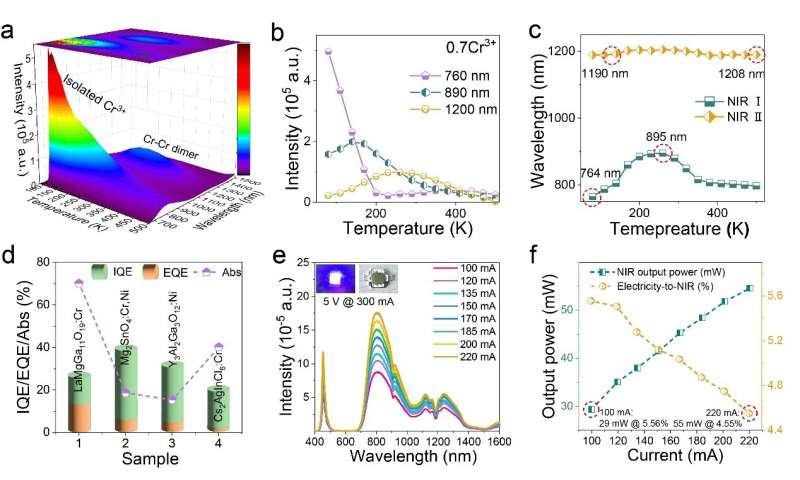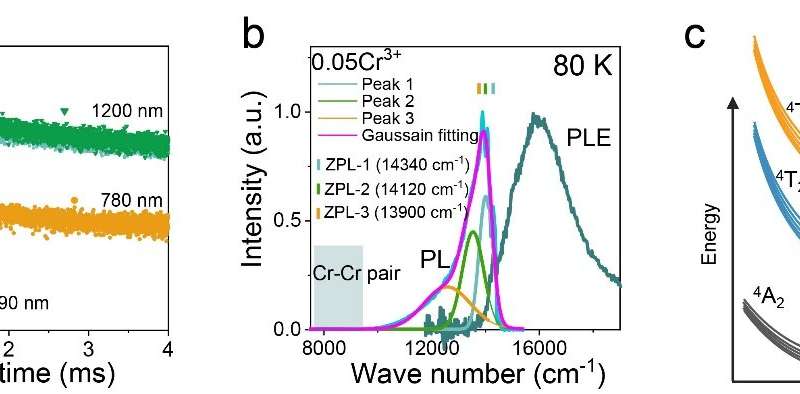Intervalence charge transfer of Cr³⁺-Cr³⁺ aggregation for NIR-II luminescence

The near-infrared (NIR) spectrum contains characteristic vibrational absorption bands of numerous organic functional groups. NIR phosphor-converted light-emitting diodes (pc-LEDs) have gathered increasing interests in fields including non-destructive testing and night vision.
In 2016, Osram reported the first NIR pc-LED, SFH4735, while with low output power (16 mW @ 350 mA) and limited wavelengths. Furthermore, luminescent contrast agents operating within the second biological imaging window (1,000–1,800 nm) exhibit lower tissue absorption and scattering coefficients in contrast to the traditional first window (750–950 nm), thereby enabling enhanced detection depth and improved imaging signal-to-noise ratio.
Significantly, the luminescence of Cr3+ via engineering the crystal field environment is located in the NIR-Ⅰ region, as illustrated by the Tanabe-Sugano diagram. The presence of Cr4+ ([Ar]3d2) is capable of extending the emission to the NIR-Ⅱ region, but the efficiency is subpar due to poor luminescence thermal quenching at room temperature.
In contrast, phosphors doped with lanthanide ions typically exhibit narrow-band multiplets emission, making spectral tuning a challenging task. Hence, it becomes crucial to investigate methods for achieving broadband NIR-Ⅱ luminescence through ion doping and structural composition.
In a new paper published in Light Science & Application, a team of researchers, led by Professor Quanlin Liu from School of Materials Sciences and Engineering, University of Science and Technology Beijing, China, and co-workers have developed the first-ever NIR-Ⅱ broadband luminescence based on intervalence charge transfer (IVCT) of Cr3+-Cr3+ → Cr2+,Cr4+ in magentoplumbite-type LaMgGa11O19.
Based on heavily incorporation of Cr3+ ion, LaMgGa11O19 exhibits dual-emission (NIR-Ⅰ, 890 nm and NIR-Ⅱ, 1200 nm) with a full width at half maximum (FWHM) of 626 nm and luminescence external efficiency of 18.9%. They further observed the luminescence anti-thermal quenching behavior (432% @ 290 K vs. @80 K) of target NIR-Ⅱ luminscence.
-
![Intervalence charge transfer of Cr³⁺-Cr³⁺ aggregation for NIR-Ⅱ luminescence]()
a, Cryogenic (80 K) luminescence decay curves of LaMgGa₁₁O₁₉:0.05Cr³⁺ sample monitoring at 720, 780, 890, and 1,200 nm. The luminescence decay lifetime monitoring at 1,200 nm is 2.3 ms, validating the anomalous is not related to Cr⁴⁺ impurity and magnetic interaction of Cr³⁺-Cr³⁺ pairs. b Magnified cryogenic PL and PLE spectra of LaMgGa₁₁O₁₉:0.05Cr³⁺ sample to estimate the ZPL energies; c Schematic luminescence mechanism based on IVCT. The IVCT between Cr³⁺ centers can be broken down into two separate single-center processes: the oxidation of a Cr³⁺ ion (i.e. Cr³⁺ e(VB) + Cr⁴⁺) and the reduction of another Cr³⁺ ion (i.e. Cr³⁺ + e(VB) Cr²⁺). The radiative luminescence occurs from the ⁵E ground state of Cr²⁺ ions back to the ⁴A₂ ground state of Cr³⁺. Credit: Shengqiang Liu, Jingxuan Du, Zhen Song, Chonggeng Ma, Quanlin Liu
-

a, Temperature-dependent luminescence 3D color mapping of LaMgGa₁₁O₁₉:0.7Cr³⁺ sample. b, Luminescence intensities versus temperature monitoring at 760, 890, and 1,200 nm. c, Scatters of peak positions versus temperature. It was observed with anomalous anti-thermal quenching behavior (432% @ 290 K). d, Comparison of IQE, EQE, and Abs values with some reported NIR-Ⅱ luminescent phosphors. The luminescence IQE and EQE are 27.2% and 18.9%. e, Electroluminescence spectra and photographs of the fabricated NIR pc-LED device by integrating LaMgGa₁₁O₁₉:0.7Cr³⁺ on a commercial 450 nm blue LED. f NIR output power and photoelectric conversion efficiency of the fabricated pc-LED with the tunable driven current. Credit: Shengqiang Liu, Jingxuan Du, Zhen Song, Chonggeng Ma, Quanlin Liu
They observed the NIR-Ⅰ luminescence at low concentration of Cr3+ ions, whereas the NIR-Ⅱ luminescence appears as the concentration of Cr3+ ions increases to 0.5. With a high doping concentration of Cr3+ ions, the excitation and absorption signals of Cr4+ ions cannot be traced.
Additionally, in contrast to the Cr4+ ions, they discovered significantly longer luminescence decay lifetime (2.3 ms) associated with this anomalous NIR-Ⅱ luminescence. The potential application of LaMgGa11O19:Cr3+ phosphor as a light-emitting converter in non-destructive analysis, tissue penetration, and long-distance night vision is demonstrated via fabricating a NIR pc-LED.
More information:
Shengqiang Liu et al, Intervalence charge transfer of Cr3+-Cr3+ aggregation for NIR-II luminescence, Light: Science & Applications (2023). DOI: 10.1038/s41377-023-01219-x
Citation:
Intervalence charge transfer of Cr³⁺-Cr³⁺ aggregation for NIR-II luminescence (2023, July 26)
retrieved 26 July 2023
from https://phys.org/news/2023-07-intervalence-cr-cr-aggregation-nir-ii-luminescence.html
This document is subject to copyright. Apart from any fair dealing for the purpose of private study or research, no
part may be reproduced without the written permission. The content is provided for information purposes only.
For all the latest Science News Click Here
For the latest news and updates, follow us on Google News.


